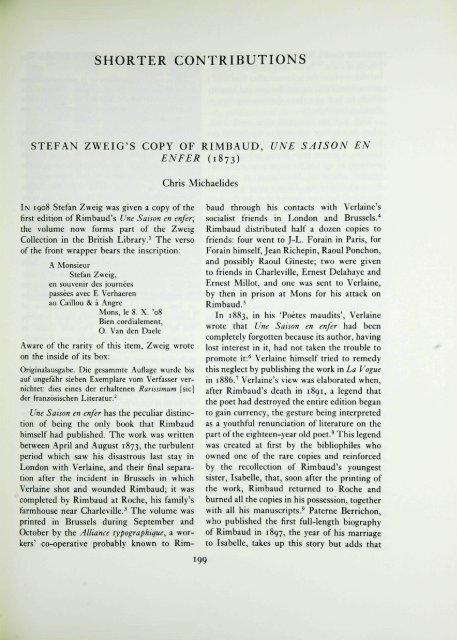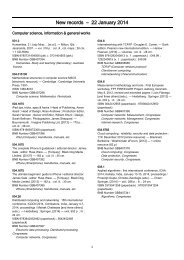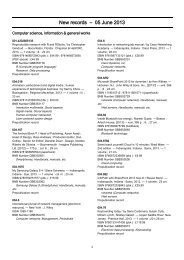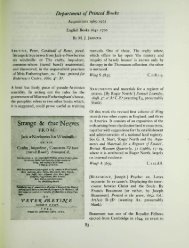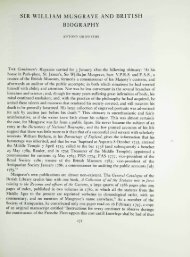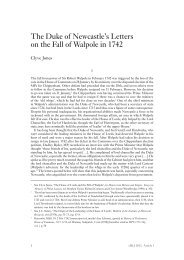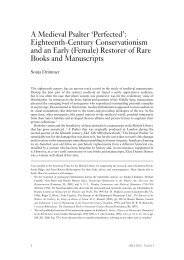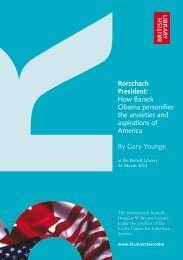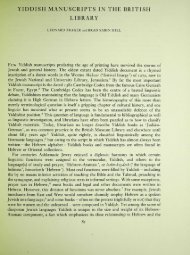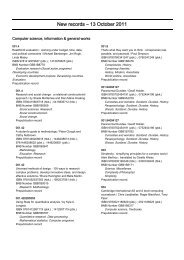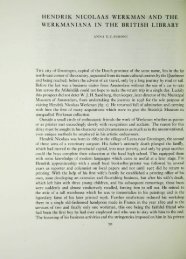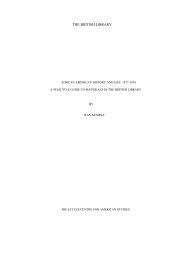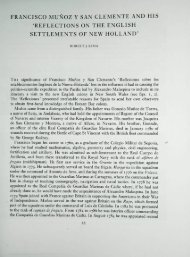Stefan Zweig's copy of Rimbaud, Une Saison en - British Library
Stefan Zweig's copy of Rimbaud, Une Saison en - British Library
Stefan Zweig's copy of Rimbaud, Une Saison en - British Library
You also want an ePaper? Increase the reach of your titles
YUMPU automatically turns print PDFs into web optimized ePapers that Google loves.
SHORTER CONTRIBUTIONS<br />
STEFAN ZWEIG'S COPY OF RIMBAUD, UNE SAISON EN<br />
ENFER (1873)<br />
IN 1908 <strong>Stefan</strong> Zweig was giv<strong>en</strong> a <strong>copy</strong> <strong>of</strong> the<br />
first edition <strong>of</strong> <strong>Rimbaud</strong>'s <strong>Une</strong> <strong>Saison</strong> <strong>en</strong> <strong>en</strong>fer;<br />
the volume now forms part <strong>of</strong> the Zweig<br />
Collection in the <strong>British</strong> <strong>Library</strong>.^ The verso<br />
<strong>of</strong> the front wrapper bears the inscription:<br />
A Monsieur<br />
<strong>Stefan</strong> Zweig,<br />
<strong>en</strong> souv<strong>en</strong>ir des journees<br />
passees avec E Verhaer<strong>en</strong><br />
au Caillou & a Angre<br />
Mons, le 8. X. '08<br />
Bi<strong>en</strong> cordialem<strong>en</strong>t,<br />
O. Van d<strong>en</strong> Daele<br />
Aware <strong>of</strong> the rarity <strong>of</strong> this item, Zweig wrote<br />
on the inside <strong>of</strong> its box:<br />
Chris Michaelides<br />
Originalausgabe. Die gesammte Auflage wurde bis<br />
auf ungefahr sieb<strong>en</strong> Exemplare vom Verfasser vernichtet:<br />
dies eines der erhalt<strong>en</strong><strong>en</strong> Rarissimum [sic]<br />
der franzosisch<strong>en</strong> Literatur.^<br />
<strong>Une</strong> <strong>Saison</strong> <strong>en</strong> <strong>en</strong>fer has the peculiar distinction<br />
<strong>of</strong> being the only book that <strong>Rimbaud</strong><br />
himself had published. The work was writt<strong>en</strong><br />
betwe<strong>en</strong> April and August 1873, the turbul<strong>en</strong>t<br />
period which saw his disastrous last stay in<br />
London with Verlaine, and their final separation<br />
after the incid<strong>en</strong>t in Brussels in which<br />
Verlaine shot and wounded <strong>Rimbaud</strong>; it was<br />
completed by <strong>Rimbaud</strong> at Roche, his family's<br />
farmhouse near Charleville.-* The volume was<br />
printed in Brussels during September and<br />
October by the Alliance typographique, a workers'<br />
co-operative probably known to Rim-<br />
199<br />
baud through his contacts with Verlaine's<br />
socialist fri<strong>en</strong>ds in London and Brussels.**<br />
<strong>Rimbaud</strong> distributed half a doz<strong>en</strong> copies to<br />
fri<strong>en</strong>ds: four w<strong>en</strong>t to J-L. Forain in Paris, for<br />
Forain himself, Jean Richepin, Raoul Ponchon,<br />
and possibly Raoul Gineste; two were giv<strong>en</strong><br />
to fri<strong>en</strong>ds in Charleville, Ernest Delahaye and<br />
Ernest Millot, and one was s<strong>en</strong>t to Verlaine,<br />
by th<strong>en</strong> in prison at Mons for his attack on<br />
<strong>Rimbaud</strong>.^<br />
In 1883, in his 'Poetes maudits', Verlaine<br />
wrote that <strong>Une</strong> <strong>Saison</strong> <strong>en</strong> <strong>en</strong>fer had be<strong>en</strong><br />
completely forgott<strong>en</strong> because its author, having<br />
lost interest in it, had not tak<strong>en</strong> the trouble to<br />
promote it:'^ Verlaine himself tried to remedy<br />
this neglect by publishing the work in La Vogue<br />
in 1886.^ Verlaine's view was elaborated wh<strong>en</strong>,<br />
after <strong>Rimbaud</strong>'s death in 1891, a leg<strong>en</strong>d that<br />
the poet had destroyed the <strong>en</strong>tire edition began<br />
to gain curr<strong>en</strong>cy, the gesture being interpreted<br />
as a youthful r<strong>en</strong>unciation <strong>of</strong> literature on the<br />
part <strong>of</strong> the eighte<strong>en</strong>-year old poet.® This leg<strong>en</strong>d<br />
was created at first by the bibliophiles who<br />
owned one <strong>of</strong> the rare copies and reinforced<br />
by the recollection <strong>of</strong> <strong>Rimbaud</strong>'s youngest<br />
sister, Isabelle, that, soon after the printing <strong>of</strong><br />
the work, <strong>Rimbaud</strong> returned to Roche and<br />
burned all the copies in his possession, together<br />
with all his manuscripts.^ Paterne Berrichon,<br />
who published the first full-l<strong>en</strong>gth biography<br />
<strong>of</strong> <strong>Rimbaud</strong> in 1897, the year <strong>of</strong> his marriage<br />
to Isabelle, takes up this story but adds that
<strong>Rimbaud</strong> saved a few copies for distribution to realizing their importance.^^ Wh<strong>en</strong> this was<br />
tri<strong>en</strong>ds in Paris.'** In his 1912 study <strong>of</strong> the poet, revealed to him:<br />
Berrichon places the holocaust after <strong>Rimbaud</strong>'s . . . il lacha les exemplaires de la precieuse edition<br />
return from Paris, the indiffer<strong>en</strong>ce and hostility au compte-goutte.'^ J'<strong>en</strong> deti<strong>en</strong>s un—comme il s'<strong>en</strong><br />
which he had met there determining him to doit. Emile Verhaer<strong>en</strong>, <strong>Stefan</strong> Zweig, Viele-Griffin<br />
abandon literature." ^^ quelques autres ecrivains ou amateurs de ma<br />
This was the accepted view until 1914, connaissance <strong>en</strong> ont re9u un'cadeau'.<br />
wh<strong>en</strong>, in a lecture delivered to the Societe des Pierard's version would seem to be more<br />
bibliopbiles et iconophiles de Belgique, Leon convincing as an explanation <strong>of</strong>the long interval<br />
Losseau, a lawyer from Mons, announced his betwe<strong>en</strong> Losseau's discovery in 1901 and its<br />
discovery in 1901 <strong>of</strong>the <strong>en</strong>tire print-run <strong>of</strong>the revelation in 1914. Losseau's explanation <strong>of</strong>the<br />
original edition <strong>of</strong> <strong>Une</strong> <strong>Saison</strong> <strong>en</strong> <strong>en</strong>fer in delay is hardly helped by his expressed inthe<br />
workshop <strong>of</strong> the Alliance typographique in t<strong>en</strong>tion <strong>of</strong> distributing copies to the Societe des<br />
Brussels.'^ Losseau claimed that, by checking bibliophiles beiges seant a Mons and this body<br />
the printer's account books, he had established was, in any case, limited by its rules to fifty<br />
that <strong>Rimbaud</strong> had made an initial paym<strong>en</strong>t for members.^'' However, if Pierard's account is<br />
the printing but had failed to settle the account the right one, the inscription on <strong>Zweig's</strong> <strong>copy</strong><br />
and that, <strong>of</strong> the five hundred copies printed, demonstrates that the discovery <strong>of</strong>the edition<br />
he had received no more than a doz<strong>en</strong> author's must have occurred in or before October 1908.<br />
copies. The rest remained forgott<strong>en</strong> in the Whatever the exact sequ<strong>en</strong>ce <strong>of</strong> ev<strong>en</strong>ts, both<br />
printer's storeroom until they were accid<strong>en</strong>tally accounts agree that the pres<strong>en</strong>tation <strong>of</strong> a <strong>copy</strong><br />
discovered tw<strong>en</strong>ty-eight years later. After an <strong>of</strong> <strong>Une</strong> <strong>Saison</strong> <strong>en</strong> <strong>en</strong>fer to Zweig was made at<br />
unspecified number <strong>of</strong> copies, badly damaged the instance <strong>of</strong> a third party, and Pierard more<br />
by water, had be<strong>en</strong> burnt, Losseau was left or less names himself as the instigator <strong>of</strong><br />
with 425 copies, which, with the half doz<strong>en</strong> Losseau's gifts. Here Pierard's claim is borne<br />
giv<strong>en</strong> away to fri<strong>en</strong>ds by <strong>Rimbaud</strong>, comprised out by the signature 'O. Van d<strong>en</strong> Daele' in<br />
the surviving edition. <strong>Zweig's</strong> <strong>copy</strong>. Van d<strong>en</strong> Daele was Pierard's<br />
Losseau states, rather unconvincingly, that teacher and fri<strong>en</strong>d, and the dedicatee <strong>of</strong> Pierhis<br />
main reason for buying the edition was to ard's first poems,'London Sketches';'^ perhaps<br />
pres<strong>en</strong>t copies <strong>of</strong> it to his fellow members <strong>of</strong> he was also the fri<strong>en</strong>d with whom Pierard<br />
the Societe des bibliophiles beiges seant a Mons discovered the edition in Losseau's attic.<br />
wh<strong>en</strong> they next met at his house. To do this <strong>Zweig's</strong> <strong>copy</strong> was giv<strong>en</strong> to him as a souv<strong>en</strong>ir<br />
he had had to wait until 24 November 1912!^^ <strong>of</strong>the days sp<strong>en</strong>t in the company <strong>of</strong> Verhaer<strong>en</strong><br />
In the meantime he gave copies to a few close at Caillou qui Bique, a hamlet near Angre, in<br />
fri<strong>en</strong>ds, whom he swore to secrecy, and, upon the Walloon district (fig. i). Zweig first met<br />
a request made to him, distributed others to Verhaer<strong>en</strong> in 1902 and soon became his close<br />
Emile Verhaer<strong>en</strong>, Maurice Maeterlinck, Viele- fri<strong>en</strong>d and disciple.'^ Their fri<strong>en</strong>dship, which<br />
Griffin, and <strong>Stefan</strong> Zweig.'"^ was to last until the outbreak <strong>of</strong> the First World<br />
This account by Losseau has be<strong>en</strong> contested War,^^ was mutually b<strong>en</strong>eficial: Zweig, through<br />
by Louis Pierard, the Belgian journalist, poet, his translations <strong>of</strong> Verhaer<strong>en</strong>'s poems and plays<br />
and art critic. In an article published in 1942, made his name, hitherto confused with that <strong>of</strong><br />
Pierard claimed that 'around 1912' he and a Verlaine, familiar to German readers,^^ while<br />
fri<strong>en</strong>d discovered, in the attic <strong>of</strong> Losseau's Verhaer<strong>en</strong> introduced his young disciple to<br />
house, over 250 copies <strong>of</strong> <strong>Une</strong> <strong>Saison</strong> <strong>en</strong> <strong>en</strong>fer Parisian literary and artistic circles. During the<br />
which'Losseau had bought as part <strong>of</strong>the <strong>en</strong>tire period <strong>of</strong> their fri<strong>en</strong>dship, Verhaer<strong>en</strong> sp<strong>en</strong>t the<br />
stock <strong>of</strong> the Alliance typographique, without winter months in Paris and the rest <strong>of</strong> the year<br />
200
Fig. I. Zweig (c<strong>en</strong>tre) with the Verhaer<strong>en</strong>s at<br />
Caillou qui Bique, from E. Rieger, <strong>Stefan</strong><br />
Zweig (Berlin, 1928)<br />
at Caillou. Zweig admired this equilibrium <strong>of</strong><br />
a life shared betwe<strong>en</strong> the big city and the<br />
countryside, Verhaer<strong>en</strong> the citiz<strong>en</strong> <strong>of</strong>the world<br />
complem<strong>en</strong>ting the hermit <strong>of</strong> Caillou qui Bique<br />
in total communion with Nature. In his Erinnerung<strong>en</strong><br />
an Emile Verhaer<strong>en</strong>, writt<strong>en</strong> soon after<br />
the poet's tragic death in 1916 and privately<br />
printed in 1917, Zweig lovingly evokes Verhaer<strong>en</strong>'s<br />
house at St. Cloud, near Paris, and<br />
his cottage at Caillou,^^ He sp<strong>en</strong>t five summers<br />
at Caillou as Verhaer<strong>en</strong>'s guest and these he<br />
always remembered with a gratitude close to<br />
v<strong>en</strong>eration, the more so after the destruction<br />
<strong>of</strong> the cottage in 1917. He relates that the<br />
cottage at Caillou became a place <strong>of</strong> pilgrimage<br />
for Verhaer<strong>en</strong>'s fri<strong>en</strong>ds and that<br />
celui qui etait re^u ici, etait un ami et un hote<br />
201<br />
qui ne faisait que passer, fugitif, mais dev<strong>en</strong>ait partie<br />
de la maison, partageait le pain, les heures et le<br />
sil<strong>en</strong>ce."<br />
Pierard, a native <strong>of</strong> near-by Frameries, lived<br />
until 1911 at Mons, where he was involved in<br />
the publication <strong>of</strong> Antee and La Societe nouvelle,<br />
both <strong>of</strong> them reviews to which Verhaer<strong>en</strong> was<br />
an occasional contributor. He was introduced<br />
to Verhaer<strong>en</strong> while still at school, probably by<br />
Van d<strong>en</strong> Daele, and, like Zweig, he quickly<br />
became a privileged visitor at Caillou.^ In<br />
1907 he dedicated his Images boraines to Verhaer<strong>en</strong><br />
and, in an article published in La Societe<br />
nouvelle in 1908, he describes Verhaer<strong>en</strong> reciting<br />
his rec<strong>en</strong>tly completed play Hel<strong>en</strong>e de<br />
Sparte to a gathering <strong>of</strong> fri<strong>en</strong>ds at the cottage:<br />
. . . et Verhaer<strong>en</strong> comm<strong>en</strong>ce sa lecture, le corps<br />
arque, le cou aux veines saillantes t<strong>en</strong>du, le bras<br />
allonge, ainsi que !e repres<strong>en</strong>ter<strong>en</strong>t Van Rysselberghe<br />
et Montald. C'est surtout la main nerveuse,<br />
fine et agile, qui lit Hel<strong>en</strong>e de Sparte cep<strong>en</strong>dant que<br />
les mots ^emissants, que les vers fougueux se<br />
press<strong>en</strong>t aux levres du poete.<br />
L'oeuvre, que M. Valere Brussov traduit <strong>en</strong> russe<br />
pour Viessy et, <strong>en</strong> allemand, M. <strong>Stefan</strong> Zweig, est<br />
achevee depuis peu . . .^^<br />
One <strong>of</strong> <strong>Zweig's</strong> most precious memories from<br />
Caillou is <strong>of</strong> an amusing incid<strong>en</strong>t during a<br />
reading <strong>of</strong> this play, possibly the same<br />
occasion.^"^<br />
<strong>Zweig's</strong> fri<strong>en</strong>dship with Pierard began at<br />
Caillou but continued long after Verhaer<strong>en</strong>'s<br />
death in 1916. The choice <strong>of</strong> Zweig as one <strong>of</strong><br />
the privileged recipi<strong>en</strong>ts <strong>of</strong> copies <strong>of</strong> the first<br />
edition <strong>of</strong> <strong>Une</strong> <strong>Saison</strong> <strong>en</strong> <strong>en</strong>fer was an appropriate<br />
one, and Pierard must have known <strong>of</strong><br />
<strong>Zweig's</strong> interest in <strong>Rimbaud</strong>. In 1905 Zweig<br />
had published a study <strong>of</strong> Verlaine, which<br />
included a chapter on his relationship with<br />
<strong>Rimbaud</strong>,^*^ and in 1907 he wrote a criticalbiographical<br />
foreword to a German translation<br />
<strong>of</strong> <strong>Rimbaud</strong>'s poems.^^ In these works Zweig,<br />
who had read Berrichon's biography and his<br />
edition <strong>of</strong>the poet's letters,^^ and who had also<br />
met Georges Izambard, <strong>Rimbaud</strong>'s schoolmaster,<br />
in Paris, seems to be familiar with the
theory that <strong>Rimbaud</strong> had abandoned literature<br />
at eighte<strong>en</strong>. Curiously though, he appears to<br />
be unaware <strong>of</strong> the fact, m<strong>en</strong>tioned by Berrichon,<br />
that <strong>Rimbaud</strong> did have <strong>Une</strong> <strong>Saison</strong> <strong>en</strong><br />
<strong>en</strong>fer printed and th<strong>en</strong>, supposedly, destroyed<br />
the edition.^° The gift <strong>of</strong> the volume was to<br />
put him right on that score, and by the time<br />
he wrote the note which accompanies his <strong>copy</strong>,<br />
Zweig also knew about the copies s<strong>en</strong>t out by<br />
<strong>Rimbaud</strong>, though evid<strong>en</strong>tly not about those in<br />
Losseau's possession.<br />
Despite his great admiration for <strong>Rimbaud</strong>'s<br />
poetry and the fascination that the poet's<br />
trem<strong>en</strong>dous vitahty and adv<strong>en</strong>turous life held<br />
for him, Zweig never wrote a full biography <strong>of</strong><br />
<strong>Rimbaud</strong>. Yet, in a letter dated 23 September<br />
1924, thanking Pierard for a <strong>copy</strong> <strong>of</strong> his biography<br />
<strong>of</strong> Van Gogh, he writes, 'La vie de<br />
<strong>Rimbaud</strong> exceptee, nuUe autre biographie<br />
moderne me semble aussi grandiose et emouvantc'.^'<br />
In the same letter, which is suffused<br />
with <strong>Zweig's</strong> affection for Verhaer<strong>en</strong>, he m<strong>en</strong>tions<br />
the pleasure that a rec<strong>en</strong>t meeting with<br />
Verhaer<strong>en</strong>'s widow gave him and urges Pierard<br />
to take the initiative in having a monum<strong>en</strong>t<br />
erected to Verhaer<strong>en</strong> in Belgium. He also adds<br />
that the book gave him great pleasure, not only<br />
because <strong>of</strong> its excell<strong>en</strong>ce,'. . . mais aussi comme<br />
souv<strong>en</strong>ir de la belle epoque passee pres de<br />
Verhaer<strong>en</strong>', thus echoing the inscription on the<br />
book giv<strong>en</strong> to him at a time and in a world<br />
irretrievably lost.<br />
Thanks are due to Dr. Graham K<strong>en</strong>t and Mr.<br />
David Paisey for their help in the preparation <strong>of</strong><br />
this article.<br />
1 A. <strong>Rimbaud</strong>, <strong>Une</strong> <strong>Saison</strong> <strong>en</strong> <strong>en</strong>fer (Brussels,<br />
1873). Zweig 202. The <strong>copy</strong> is in a full leather<br />
binding by E. A. Enders, Leipzig.<br />
2 'First edition. The <strong>en</strong>tire edition was destroyed<br />
by the author with the exception <strong>of</strong> about sev<strong>en</strong><br />
copies. This is one oUhe rarest books in Fr<strong>en</strong>ch<br />
literature.'<br />
3 Pierre Petitfils, <strong>Rimbaud</strong> (Paris, 1982), pp. 201-<br />
27.<br />
4 Arthur <strong>Rimbaud</strong>, <strong>Une</strong> <strong>Saison</strong> <strong>en</strong> <strong>en</strong>fer, edition<br />
critique par Pierre Brunei (Paris, 1987), p. 181.<br />
202<br />
5 Petitfils, Rtmbaud, p. 230.<br />
6 Les Poetes maudits de Paul Verlaine, introduction<br />
et notes par Michel Decaudin (Paris, 1982),<br />
p. 36. Verlaine's articles originally appeared in<br />
Lutece, in 1883, before they were published in<br />
book form in 1884.<br />
7 La Vogue, nos. 8-10 (6-27 Sept. 1886). The<br />
work was also included in collections <strong>of</strong> <strong>Rimbaud</strong>'s<br />
poems and prose poems published in<br />
1892 (with a note by Verlaine) and 1898.<br />
8 Arthur <strong>Rimbaud</strong>, Reliquaire. Poesies, preface<br />
de Rodolphe Darz<strong>en</strong>s (Paris, 1891), pp. x, xi.<br />
Darz<strong>en</strong>s seems to have be<strong>en</strong> the first to m<strong>en</strong>tion<br />
<strong>Rimbaud</strong>'s destruction <strong>of</strong> the edition, locating<br />
three extant copies, his own, Jean Richepin's<br />
and Verlaine's. C. Maurras, in his obituary note<br />
on <strong>Rimbaud</strong>, published in the Revue <strong>en</strong>cyclopedtque,<br />
no. 26, tom. ii (Jan. 1892), adds another<br />
<strong>copy</strong>, owned by Raoul Gineste, to those mi<strong>en</strong>tioned<br />
by Darz<strong>en</strong>s.<br />
9 See her letters to Louis Pierquin in Arthur<br />
<strong>Rimbaud</strong>, Oeuvres completes, edition etablie, pres<strong>en</strong>tee<br />
et annotee par Antoine Adam. Bibliotheque<br />
de la Pleiade no. 68 (Paris, 1972), pp.<br />
722, 732-3. Isabelle, who only found out about<br />
her brother's literary reputation after his death,<br />
and thereafter became his hagiographer, tried,<br />
unsuccessfully, to prev<strong>en</strong>t the publication <strong>of</strong> her<br />
brother's works on the grounds that he had<br />
never int<strong>en</strong>ded them for publication.<br />
10 P. Berrichon, La Vie de Jean-Arthur <strong>Rimbaud</strong><br />
(Paris, 1897), pp. 94-5, 98-9-<br />
11 P. Berrichon, Jean-Arthur <strong>Rimbaud</strong>, le poete<br />
ii8s4-fS73) (Paris, 1912), pp. 294-5.<br />
12 Leon Losseau, La Leg<strong>en</strong>de de la destruction par<br />
<strong>Rimbaud</strong> de I'editwn prmceps de <strong>Une</strong> <strong>Saison</strong> <strong>en</strong>^<br />
<strong>en</strong>fer. Extrait de I'Annuaire de 1915 de la Societe<br />
des bibliophiles et iconophiles de Belgique (Brussels,<br />
1916). One consequ<strong>en</strong>ce <strong>of</strong> Losseau's discovery,<br />
and <strong>of</strong> the subsequ<strong>en</strong>t destruction <strong>of</strong> the myth<br />
about <strong>Rimbaud</strong>'s adieu a la litterature, was the<br />
revision <strong>of</strong>the dating <strong>of</strong>the Illuminations, which<br />
are now g<strong>en</strong>erally considered to have be<strong>en</strong><br />
writt<strong>en</strong> after <strong>Une</strong> <strong>Saison</strong> <strong>en</strong> <strong>en</strong>fer.<br />
13 Bulletin, Societe des bibliophiles beiges seant a<br />
Mons, i, 5e fasc. (1914), P- 213. Losseau, La<br />
Leg<strong>en</strong>de, p. 3, gives the date as 24 December<br />
1912.<br />
14 Losseau, ibid., p. 16.<br />
15 L. Pierard, 'L'edition originale d'C/»f <strong>Saison</strong> <strong>en</strong><br />
<strong>en</strong>fer\ Poesie 42, i, pp. 14-15-<br />
16 Losseau was to continue to give away copies <strong>of</strong>
<strong>Une</strong> <strong>Saison</strong> <strong>en</strong> <strong>en</strong>fer for many years—he donated<br />
a <strong>copy</strong> to the Bibliotheque nationale in 1938. A<br />
<strong>copy</strong> he gave to Jules Mouquet was purchased<br />
by the <strong>British</strong> <strong>Library</strong> in 1982 (C.i29.m.i3.).<br />
This <strong>copy</strong> has two interlaced Ls stamped in the<br />
upper blank margin <strong>of</strong> the front wrapper and<br />
below the last line <strong>of</strong> text; on the first page it<br />
has the inscription 'A Monsieur Jules Mouquet,<br />
l'editeur des Vers de college d'Arthur <strong>Rimbaud</strong>'<br />
(Mouquet's edition was published in 1933). It<br />
is in a fine binding by Rose Adler, signed and<br />
dated 1948. Reproduced in Martin Breslauer,<br />
Fine Bindings Catalogue 104, part II, (1981),<br />
col. pi. xiii.<br />
17 Bulletin, i, ler fasc. (1908), p. [3].<br />
18 Revue de Belgique, Annee 37 (Oct. 1905), pp.<br />
105-11.<br />
19 Robert Dumont, <strong>Stefan</strong> Zweig et la France<br />
(Paris, 1967), pp. 31-88, discusses the fri<strong>en</strong>dship<br />
betwe<strong>en</strong> the two m<strong>en</strong>, Verhaer<strong>en</strong>'s influ<strong>en</strong>ce on<br />
Zweig and <strong>Zweig's</strong> writings on the poet. See<br />
also D. A. Prater, European <strong>of</strong> yesterday: a<br />
biography <strong>of</strong> <strong>Stefan</strong> Zweig (Oxford, 1972), pp.<br />
22-98 passim.<br />
20 Zweig was deeply hurt by Verhaer<strong>en</strong>'s expression<br />
<strong>of</strong> bitter anti-German feelings in works such as<br />
La Belgique sanglante and Les Ailes rouges de la<br />
guerre, writt<strong>en</strong> after the German invasion <strong>of</strong><br />
Belgium.<br />
21 For a list <strong>of</strong> <strong>Zweig's</strong> translations <strong>of</strong> Verhaer<strong>en</strong>'s<br />
works see Randolph J. Klawiter, <strong>Stefan</strong> Zweig:<br />
a bibliography. University <strong>of</strong> North Carolina<br />
Studies in the Germanic Languages and Literatures,<br />
no. 50 (Chapel Hill, 1965), pp. 70-71. In<br />
1912, Zweig also organized Verhaer<strong>en</strong>'s highly<br />
successful lecture tour in Hamburg, Berlin,<br />
Vi<strong>en</strong>na and Munich. See Prater, European <strong>of</strong><br />
Yesterday, pp. 42-4.<br />
IN April 1987 the Modern <strong>British</strong> Section<br />
<strong>of</strong> the <strong>British</strong> <strong>Library</strong> acquired a rare and<br />
important <strong>copy</strong> <strong>of</strong> W. H. Aud<strong>en</strong>'s Poems <strong>of</strong><br />
1928. This was Aud<strong>en</strong>'s first published work,<br />
privately printed by his fellow poet and undergraduate<br />
Steph<strong>en</strong> Sp<strong>en</strong>der during the Oxford<br />
W. H. AUDEN'S POEMS OF 1928<br />
Joanna Leevers<br />
203<br />
22 Zweig, Erinnerung<strong>en</strong> an Emile Verhaer<strong>en</strong><br />
(Vi<strong>en</strong>na, 1917). All refer<strong>en</strong>ces are to the Fr<strong>en</strong>ch<br />
edition Souv<strong>en</strong>irs sur Emile Verhaer<strong>en</strong> (Brussels,<br />
23 Zweig, ibid., p. 76.<br />
24 See <strong>Zweig's</strong> contribution in La nervie, numero<br />
special consacre a Louis Pierard, 1930, i, pp.<br />
20-21. See also Trois c<strong>en</strong>t tr<strong>en</strong>te-deux lettres a<br />
Louis Pierard, precedees de Memoires exterieurs<br />
par Marianne Pierson-Pierard, Lettres modernes,<br />
Avant-siecle, 11 (Paris, 1971), p. 16.<br />
25 Louis Pierard, 'Le Wallon a l'Orange', La Societe<br />
nouvelle, i4e annee, tom. ii (2e serie, vol. xxx,<br />
oct.-dec. 1908), p. 81. The German premiere <strong>of</strong><br />
Hel<strong>en</strong>e de Sparte {Hel<strong>en</strong>a's Heimkehr), in <strong>Zweig's</strong><br />
translation, was giv<strong>en</strong> on 13 October 1910, at<br />
the Stuttgarter H<strong>of</strong>theater, nearly two years<br />
before its Paris premiere, on 4 May 1912, at the<br />
Chatelet.<br />
26 Zweig, Souv<strong>en</strong>irs sur Emile Verhaer<strong>en</strong>, p. 137.<br />
27 <strong>Stefan</strong> Zweig, Paul Verlaine. Die Dichtung, Eine<br />
Sammlung von Monographi<strong>en</strong>, vol. xxx (Berlin-<br />
Leipzig, 1905). All refer<strong>en</strong>ces are tak<strong>en</strong> from the<br />
English edition, Paul Verlaine (Boston, Dublin<br />
& London, 1913), where 'The <strong>Rimbaud</strong> Episode'<br />
is on pp. 38-50.<br />
28 Arthur <strong>Rimbaud</strong>, Gedichte [tr. from the Fr<strong>en</strong>ch<br />
by K. L. Ammer {pseud, <strong>of</strong> Karl Klammer)],<br />
(Leipzig, 1907).<br />
29 Zweig, Verlaine (1913), p. 49, note. Berrichon's<br />
Lettres de Jean-Arthur <strong>Rimbaud</strong> was published<br />
in 1899.<br />
30 Zweig, ibid., p. 41: 'he never had a single line<br />
printed by his own efforts, he was utterly<br />
regardless <strong>of</strong>the fleeting examples <strong>of</strong> his gigantic<br />
power'.<br />
31 Pierson-Pierard, op. cit., p. 346.<br />
summer vacation. It is a surprisingly small<br />
volume measuring only 12 x 95 cm., bound in<br />
limp orange covers; the title-page reads: W.<br />
H. AUDEN [long rule] POEMS [short rule]<br />
S.H.S.: 1928. Its pagination is pp. [i-iv, 1-2]<br />
3-37 [38-40]^ and a printed erratum slip is


